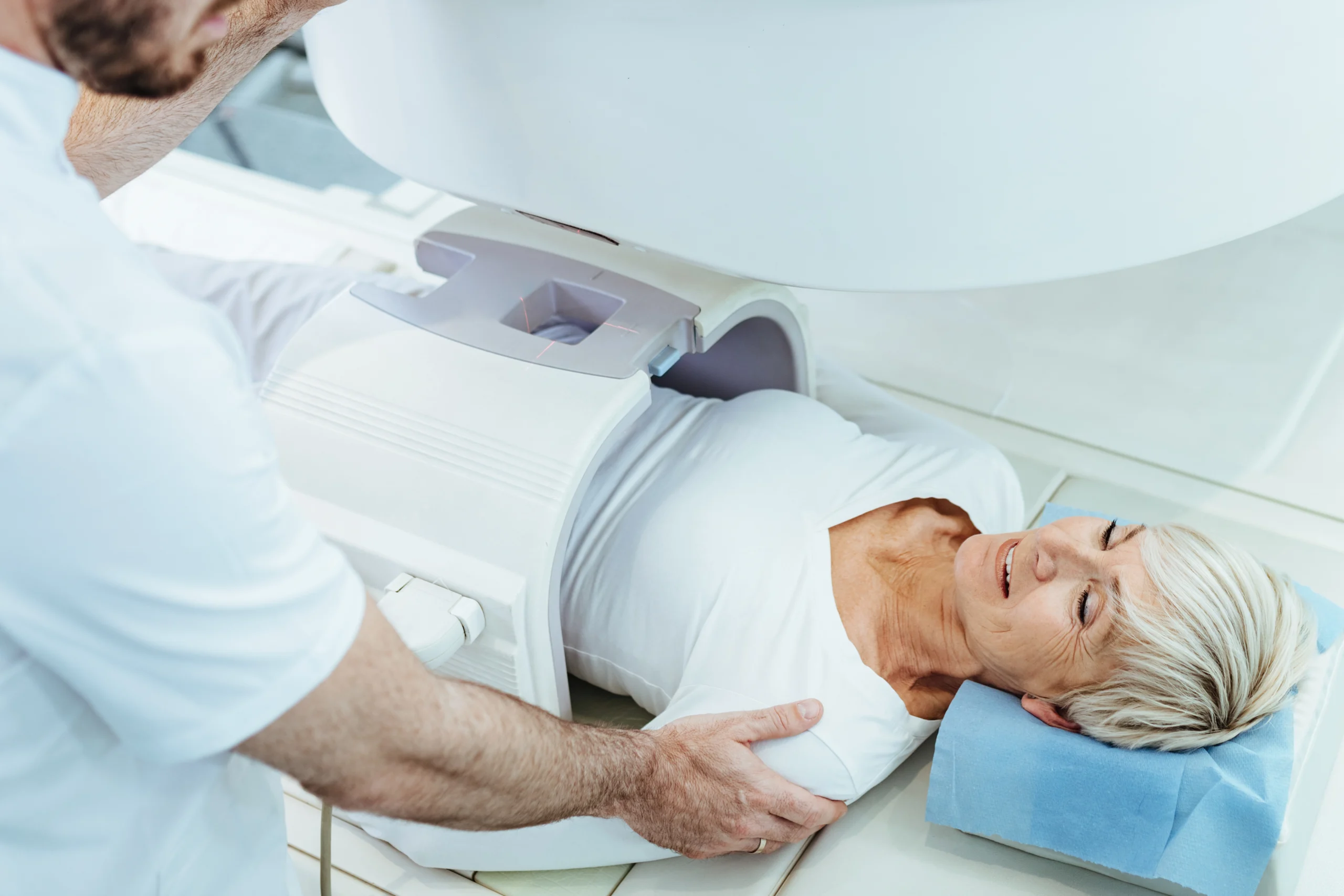A small subset of people approach our practice with the idea that I can somehow diagnose their problem without running any tests or without doing any examination of the interior of their sinonasal tract. The flip side of this is that I see people every day who have been seeing their so-called specialists for months or years and have never been properly diagnosed, precisely because their doctor has never done the appropriate studies on them to make the diagnosis.
Diagnosing and treating sinonasal issues, such as sinusitis and snoring, requires a thorough understanding of the nasal anatomy and underlying causes of symptoms. Two essential diagnostic tools in evaluating these conditions are the sinus CT scan and the endonasal scope. I use them extensively in my practice to quickly and accurately diagnose problems causing the symptoms people commonly complain of.
This post will examine the importance of combining both imaging techniques in diagnosing and treating sinusitis, snoring, and other sinonasal conditions. Additionally, it will discuss the demographics of chronic sinusitis in the United States, the relationship between nasal obstruction and snoring, as well as the strengths and limitations of sinus CT scans and endonasal scopes in identifying specific sinonasal conditions.
Demographics of Chronic Sinusitis in America
Chronic sinusitis is a prevalent condition that affects millions of Americans each year, with significant impacts on quality of life and healthcare costs. It is estimated that over 30 million adults in the United States are diagnosed with chronic sinusitis annually.
This inflammatory condition of the paranasal sinuses results in symptoms such as nasal congestion, facial pain, postnasal drip, and reduced sense of smell. While acute sinusitis is usually caused by bacterial or viral infections, chronic sinusitis may result from various factors, including allergies, anatomical abnormalities, or underlying immune disorders.
Understanding the demographic factors associated with chronic sinusitis can help tailor diagnostic and treatment approaches for individuals affected by this condition.
Connection Between Nasal Obstruction and Snoring
Nasal obstruction has been recognized as a significant contributing factor to snoring and obstructive sleep apnea. When the nasal passages are partially or completely blocked, airflow becomes turbulent during breathing, resulting in vibrations of the soft tissues in the airway and producing the characteristic sound of snoring.
Chronic conditions, such as nasal congestion, a deviated septum, nasal polyps, or enlarged turbinates, can lead to nasal obstruction, exacerbating snoring and sleep-disordered breathing. Addressing nasal obstruction through appropriate diagnosis and treatment methods is crucial for managing snoring and improving sleep quality in individuals affected by this condition.
Role of Sinus CT Scan in Diagnosing Chronic Sinusitis
Sinus CT scan, also known as computed tomography of the sinuses, is a valuable imaging modality for evaluating the paranasal sinuses and diagnosing chronic sinusitis. CT scans provide detailed cross-sectional images that can reveal the extent of sinus inflammation, mucosal thickening, polyps, or other structural abnormalities within the sinuses.
Compared to conventional X-rays or nasal endoscopy, sinus CT scans offer superior visualization of sinus anatomy and pathology, making them particularly effective in diagnosing chronic sinusitis. Radiologists can assess the severity and distribution of sinus disease based on CT findings, guiding treatment decisions and surgical planning for patients with persistent sinonasal symptoms.
Role of Endonasal Scope in Diagnosing Allergy, Nasal Polyps, and Other Sinus Conditions
Endonasal scope, also known as nasal endoscopy, is a minimally invasive procedure that allows for direct visualization of the nasal cavity and nasopharynx using a thin, flexible instrument equipped with a light source and a camera. Endoscopic examination of the nasal passages is essential in diagnosing conditions such as allergic rhinitis, nasal polyps, and anatomical abnormalities that contribute to nasal obstruction.
Unlike sinus CT scans, endonasal scopes provide real-time views of the nasal mucosa, allowing for the detection of subtle changes, allergic reactions, or polypoid growths that may not be apparent on imaging studies alone. By combining endonasal scope findings with patient history and allergy testing, otolaryngologists can accurately identify the underlying causes of nasal obstruction and tailor treatment plans accordingly.
Computed tomography scans play a critical role in evaluating chronic maxillary sinusitis and other forms of chronic rhinosinusitis by providing high-resolution images of the sinus cavities. These scans can reveal structural abnormalities, mucosal thickening, and the presence of nasal polyps, helping clinicians identify contributing factors to persistent inflammation. In patients with underlying conditions such as cystic fibrosis, computed tomography scans are particularly valuable in detecting characteristic changes in the sinus cavities, which aids in accurate diagnosis and tailored treatment planning.
Is Computed Tomography (CT) the Best Tool for Identifying the Risk Factors of Chronic Rhinosinusitis?
Computed tomography scans play a critical role in evaluating chronic maxillary sinusitis and other forms of chronic rhinosinusitis by providing high-resolution images of the sinus cavities. These scans can reveal structural abnormalities, mucosal thickening, and the presence of nasal polyps, helping clinicians identify contributing factors to persistent inflammation. In patients with underlying conditions such as cystic fibrosis, computed tomography scans are particularly valuable in detecting characteristic changes in the sinus cavities, which aids in accurate diagnosis and tailored treatment planning.
Is Radiologic Imaging (CT Scans) Harmful?
While CT scans are highly effective for diagnosing sinus conditions, they do involve a level of radiation exposure. For this reason, they are typically used only when clinically necessary and when the benefits outweigh the risks. In some cases, magnetic resonance imaging (MRI) scans may be considered as an alternative, especially when soft tissue evaluation is needed without the use of ionizing radiation. However, for visualizing bone structures and sinus cavities, CT scans remain the preferred option.
Do We Use Contrast Dye During Diagnostic Scans?
At Texas Sinus & Snoring, our medical team does not use contrast dye during diagnostic scans for sinus evaluation. Since our focus is on assessing the structure of the sinuses and nasal passages rather than blood vessels, contrast enhancement is unnecessary. This approach allows us to obtain clear and accurate images while minimizing patient discomfort and avoiding potential reactions to contrast materials.
Do CT Scans and Endoscopy Evaluate Only the Maxillary Sinus?
CT scans and nasal endoscopy evaluate much more than just the maxillary sinus—they also provide detailed views of the ethmoid sinuses, which are often involved in chronic sinus conditions. A CT scanner produces cross-sectional images that help assess overall sinus health, revealing inflammation, blockage, or structural issues across multiple sinus regions. During nasal endoscopy, the physician can directly visualize areas like the middle meatus, a key drainage pathway, to correlate imaging findings with real-time observations. This comprehensive approach ensures a more accurate diagnosis and effective treatment plan.
Who Can Benefit From an Endoscopic Sinus Surgery?
Endoscopic sinus surgery can be highly beneficial for adult and pediatric patients who suffer from persistent sinus problems that do not respond to maximal medical therapy. Individuals with chronic pain, frequent or severe sinus infection, or those needing treatment for conditions such as nasal polyps or blocked frontal sinuses may be ideal candidates. This minimally invasive procedure enables the targeted treatment of affected areas, including the frontal and maxillary sinuses, and is often completed in just a few hours. In some advanced cases, where there is concern about complications like intracranial extension, surgery becomes especially important to protect surrounding structures and restore proper sinus drainage.
Can We Treat Acute Sinusitis With Conservative Methods?
Receive Professional CT Sinus Scans and Endoscopy at Our Center
At our center, patients receive comprehensive evaluations from our ENT (ear, nose, throat) specialist using both CT scans and nasal endoscopy. These diagnostic tools produce detailed images that help us assess sinus pressure, identify a deviated septum, and uncover signs of inflammation or infection. We rely on CT scan findings and endoscopic findings to guide diagnosis and treatment, especially in patients with persistent symptoms that haven’t improved with basic therapies. When necessary, we incorporate allergy testing to understand the root cause of sinus problems. Grounded in clinical research and focused on excellent patient care, our approach enables us to treat nasal polyps and other chronic conditions with precision and lasting results.
Conclusion: Endoscopy and CT Scan for Chronic Sinusitis
In the evaluation and management of sinonasal conditions, the combined use of sinus CT scan and endonasal scope offers a comprehensive approach to diagnosing chronic sinusitis, snoring, and other nasal issues.
A sinus CT scan provides detailed anatomical information and aids in identifying sinus-specific pathology, making it an invaluable tool for assessing chronic sinusitis and guiding treatment decisions.
On the other hand, an endonasal scope enables direct visualization of the nasal cavity, facilitating the diagnosis of conditions such as nasal polyps, allergic rhinitis, and septal deviation that contribute to nasal obstruction and associated symptoms like snoring.
By leveraging the strengths of both diagnostic modalities, healthcare providers can achieve accurate diagnoses and individualized treatment plans for patients with sinonasal disorders, ultimately improving outcomes and quality of life for those affected by chronic sinusitis, snoring, and related conditions.




